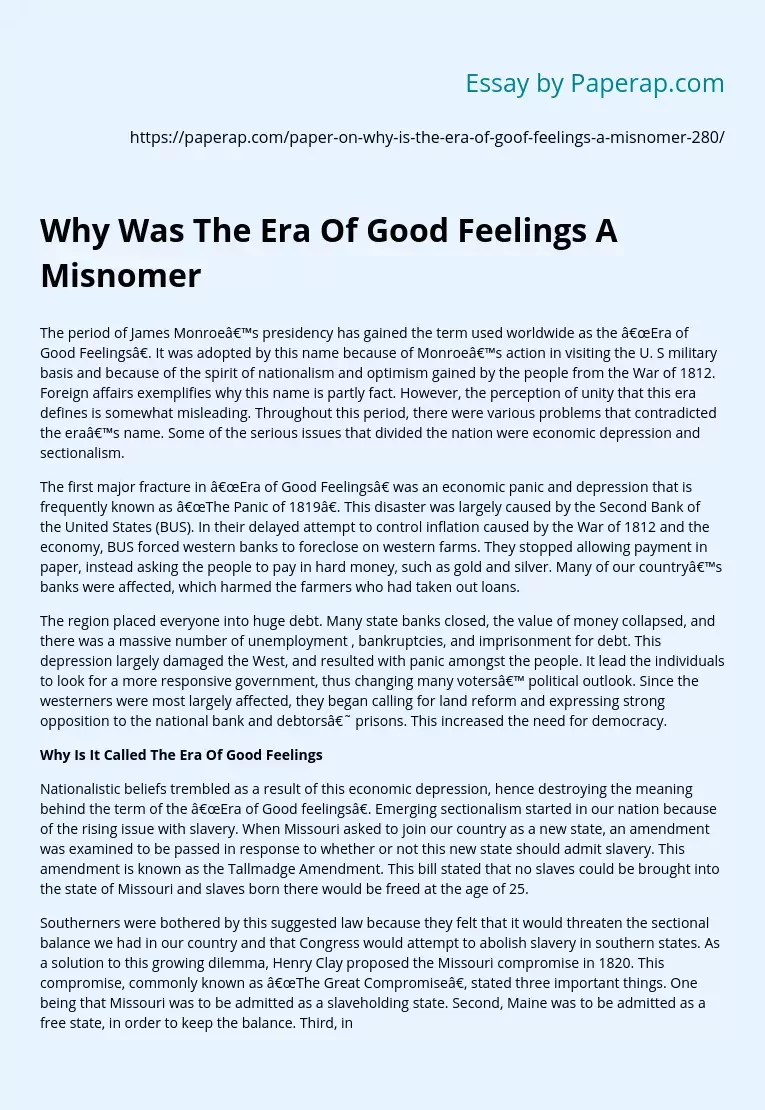Why Was The Era Of Good Feelings A Misnomer
The period of James Monroe’s presidency has gained the term used worldwide as the “Era of Good Feelings”. It was adopted by this name because of Monroe’s action in visiting the U. S military basis and because of the spirit of nationalism and optimism gained by the people from the War of 1812. Foreign affairs exemplifies why this name is partly fact. However, the perception of unity that this era defines is somewhat misleading. Throughout this period, there were various problems that contradicted the era’s name.
Some of the serious issues that divided the nation were economic depression and sectionalism.
The first major fracture in “Era of Good Feelings” was an economic panic and depression that is frequently known as “The Panic of 1819”. This disaster was largely caused by the Second Bank of the United States (BUS). In their delayed attempt to control inflation caused by the War of 1812 and the economy, BUS forced western banks to foreclose on western farms.
They stopped allowing payment in paper, instead asking the people to pay in hard money, such as gold and silver. Many of our country’s banks were affected, which harmed the farmers who had taken out loans.
The region placed everyone into huge debt. Many state banks closed, the value of money collapsed, and there was a massive number of unemployment , bankruptcies, and imprisonment for debt. This depression largely damaged the West, and resulted with panic amongst the people. It lead the individuals to look for a more responsive government, thus changing many voters’ political outlook.
Since the westerners were most largely affected, they began calling for land reform and expressing strong opposition to the national bank and debtors‘ prisons. This increased the need for democracy.
Why Is It Called The Era Of Good Feelings
Nationalistic beliefs trembled as a result of this economic depression, hence destroying the meaning behind the term of the “Era of Good feelings”. Emerging sectionalism started in our nation because of the rising issue with slavery. When Missouri asked to join our country as a new state, an amendment was examined to be passed in response to whether or not this new state should admit slavery. This amendment is known as the Tallmadge Amendment. This bill stated that no slaves could be brought into the state of Missouri and slaves born there would be freed at the age of 25.
Southerners were bothered by this suggested law because they felt that it would threaten the sectional balance we had in our country and that Congress would attempt to abolish slavery in southern states. As a solution to this growing dilemma, Henry Clay proposed the Missouri compromise in 1820. This compromise, commonly known as “The Great Compromise”, stated three important things. One being that Missouri was to be admitted as a slaveholding state. Second, Maine was to be admitted as a free state, in order to keep the balance. Third, in the rest of the Louisiana territory north of latitude 36? 0′ , slavery was prohibited. Although this compromise was accepted by both sides of the country, it upset many Northerners, thus increasing growing sectionalism in our nation. Nevertheless, the “Era of Good feelings” was badly damaged by Americans’ torn feelings of sectional controversy over Missouri (North vs. South). The “Era of Good Feelings” can also be exemplified with positive results. Our country’s Foreign affairs grew increasingly better during this time period. After the War of 1812, the United States adopted a more aggressive nationalistic approach in its relations with other nations.
Americans were now proud to call themselves Americans and they had very positive feelings because of their battle against England, with whom they now had a better relationship with then they ever had before. President Monroe, with the immense help from Secretary of State John Quincy Adams, followed a nationalistic procedure that actively advanced American interests while maintaining peace. The “Treaty of 1818” with England, for instance, fixed the American-Canadian border. The United states gained Oregon territory without the surrender of claims plus we were able to share Newfoundland fisheries with Canada.
Another positive result during this period was the treaty known as the “Florida Purchase Treaty”. Signed in 1819, Spain surrendered Florida as well as claims to Oregon to the United States. This expanded our nation, which caused Americans to feel more positive about themselves and their country. In exchange, the United Stated paid Spain $5 million for the land and gave up all territorial claims to Texas. A very important model during this time period that had a long-term impact was “The Monroe Doctrine”.
This doctrine stated that the nations of Europe could not establish any new colonies in the western hemisphere. Although during this time the United States was too weak to make such a broad claim, this doctrine later became the cornerstone of U. S. foreign policy during the last half of the 19th century and throughout the 20th century. Despite that things appeared pleasant on the outside with a growing nationalistic country, during the “Era of Good Feelings” there was increasing disunity throughout the United States influenced by sectionalism and economic downfall.
Why Was The Era Of Good Feelings A Misnomer. (2019, Dec 05). Retrieved from https://paperap.com/paper-on-why-is-the-era-of-goof-feelings-a-misnomer-280/

